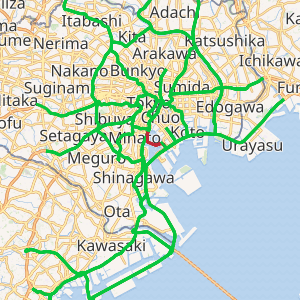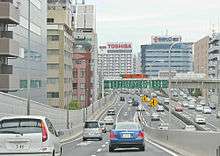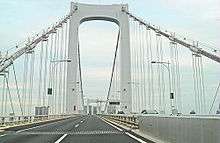Daiba Route
The Daiba Route (台場線, Daiba-sen), signed as Route 11, is one of the tolled routes of the Shuto Expressway system serving the Greater Tokyo Area. Route 11 runs from Shibaura Junction (with the Haneda Route) in Minato-ku and runs for 3.9 km through Rainbow Bridge. The Route 11 ends at the Ariake Junction connecting with the Bayshore Route in Kōtō-ku.
首都高速11号台場線 | |
|---|---|

| |
| Route information | |
| Maintained by Metropolitan Expressway Company Limited | |
| Length | 5.0 km (3.1 mi) |
| Existed | 1993–present |
| Highway system | |
| National highways of Japan Expressways of Japan | |



Originally, the route number was "12" in the urban planning.
Route description
It runs through Rainbow Bridge that is renowned for its scenery, so sometimes, especially holidays, a high concentration of cars on the bridge causes traffic congestion.
History
The entirety of the Daiba Route was opened to traffic on 26 August 1993 instead of being opened in phases like many of the other routes in the Shuto Expressway network.[1]
Exit List
| Municipality | Exit/interchange name | Destinations | Notes |
|---|---|---|---|
| Minato-ku | Shibaura JCT | Haneda Route | Accessible from outbound only |
| Minato-ku | Shibaura Rest Area | Accessible from inbound only | |
| Minato-ku | Daiba | Outbound exit/inbound entrance | |
| Kōtō-ku/Minato-ku | Ariake JCT | Bayshore Route |
Appearances in media
- Wangan Midnight, a manga and anime series based on street racing on the Wangan.
- Wangan Midnight Maximum Tune, an arcade racing game taking place on the Wangan.
- Shutokō Battle (首都高, abbreviation for "Shuto Expressway") is a Genki game based on Wangan racing
- Shutokō Battle series, an arcade Wangan racing game
- In Cars 2, a portion of the Tokyo race goes over the Rainbow Bridge.
See also


References
- "首都高の歴史". Metropolitan Expressway (in Japanese). Retrieved 8 November 2019.
External links

- 首都高速道路株式会社

